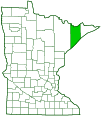Mid-winter boreus
(Boreus brumalis)
Conservation • Description • Habitat • Ecology • Distribution • Taxonomy
Conservation Status |
|
|||
| IUCN Red List | not listed |
|||
| NatureServe | NNR - Unranked |
|||
| Minnesota | not listed |
|||
Description
There are fifteen species of snow scorpionflies (family Boreidae) worldwide, thirteen species in North America, two in eastern United States including Minnesota. The two species in our state are both in the genus Boreus and are easily told apart by their color.
Mid-winter boreus is a small snow scorpionfly. It is common in the United States from Maine to Michigan, south to Tennessee, and in Canada in Nova Scotia and Ontario. There are isolated populations in Illinois, Wisconsin, and Minnesota. They are found in deciduous woodlands that have moss on the ground. Larvae live in moss and prey on small insects and other animals found in the moss, and possibly also on the moss. Adults prey on small insects and other animals found hibernating under stones and moss. They are seen on the surface of the snow on winter days when the temperature is above freezing feeding on other winter insects.
Adults are black, shiny, and stout-bodied. Females are ⅛″ (3 to 3.75 mm) long, males are slightly smaller, ⅛″ (2.5 to 2.85 mm) long.
The head is greatly elongated between the eyes and the biting mouth parts, forming a conspicuous snout (rostrum). There are two large compound eyes and no simple eyes (ocelli). The compound eyes are dull black, prominently bulging, and bare, not covered with hairs. The antennae are dull black, threadlike, and long, about half as long as the body. On females they have 22 or sometimes 23 segments, on males 23 or sometimes 24 segments. The rostrum is dull black, projected downward, cone-shaped, and about twice as long as the head.
The abdomen is black and shiny and has 10 segments. On the female it is spindle-shaped, tapered to the tenth segment which forms part of a long ovipositor-like structure. This structure, not a true ovipositor, is about half as long as the abdomen and has a needle-like tip. On the male the abdomen is cylinder-shaped. The tip is blunt and deeply notched. The last four segments are crowded together and curve upward exposing the genitalia and two prominent, stout, sharply pointed hooks.
The wings on both sexes are non-functional. The forewings on the male are leathery, 1 ⁄16″ (1.7 mm) long, and 1 ⁄64″ (0.4 mm) wide. They gradually narrow toward a long, thorn-like tip. The hindwings are bristle-like—long, slender, and chitinous—and fit into a shallow groove in the forewings. On the female the wings are small, grayish-black, oval, and scale-like.
The legs are extremely long, slender, and black. The hind legs are the longest, much longer than the body. All of the legs are densely covered with short hairs, and have a pair of spines at the tip of the fourth segment (tibia). The last part of each leg (tarsus) has five segments with a pair of small spines at the tip of the last segment.
Size
Male: ⅛″ (2.5 to 2.85 mm)
Female: ⅛″ (3 to 3.75 mm)
Similar Species
Snow-born boreus (Boreus omnivorous) is light to dark brown. It is much less common.
Habitat
Deciduous woodlands
Ecology
Season
Mid-October to April
Behavior
Life Cycle
Larva Food
Small insects and other animals found in moss, and possibly also moss.
Adult Food
Small insects and other animals found hibernating under stones and moss.
Distribution |
||
|
Sources Biodiversity occurrence data published by: Minnesota Biodiversity Atlas (accessed through the Minnesota Biodiversity Atlas Portal, bellatlas.umn.edu, 11/29/2025). |
|
| 11/29/2025 | ||
Occurrence |
||
Common but in isolated populations |
||
Taxonomy
Order
Mecoptera (Scorpionflies, Hangingflies, and Allies)
Family
Boreidae (Snow Scorpionflies)
Subfamily
Boreinae
Genus
Boreus
Subordinate Taxa
Synonyms
Common Names
mid-winter boreus
solstice snow scorpionfly
Glossary
Ocellus
Simple eye; an eye with a single lens. Plural: ocelli.
Ovipositor
A tube-like organ near the end of the abdomen of many female insects, used to prepare a place for an egg and to place the egg.
Rostrum
The stiff, beak-like projection of the carapace or prolongation of the head of an insect, crustacean, or cetacean.
Tarsus
On insects, the last two to five subdivisions of the leg, attached to the tibia; the foot. On spiders, the last segment of the leg. Plural: tarsi.
Tibia
The fourth segment of an insect leg, after the femur and before the tarsus (foot). The fifth segment of a spider leg or palp. Plural: tibiae.
Visitor Photos
Share your photo of this insect.
This button not working for you?
Simply email us at info@MinnesotaSeasons.com.
Attach one or more photos and, if you like, a caption.
|
|
|
MinnesotaSeasons.com Photos
|
|

Slideshows

Visitor Videos
Share your video of this insect.
This button not working for you?
Simply email us at info@MinnesotaSeasons.com.
Attach a video, a YouTube link, or a cloud storage link.
Other Videos

Visitor Sightings
Report a sighting of this insect.
This button not working for you?
Simply email us at info@MinnesotaSeasons.com.
Be sure to include a location.
Minnesota Seasons Sightings

